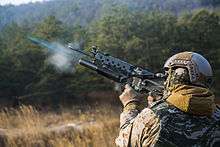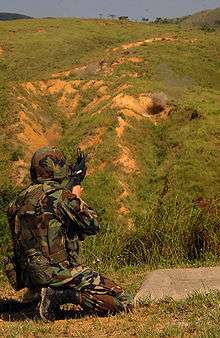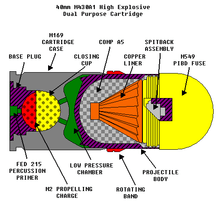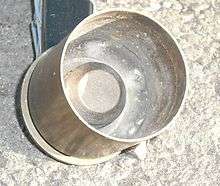M203 grenade launcher
| Launcher, Grenade, 40mm, M203 | |
|---|---|
|
(dismounted) | |
| Type | Grenade launcher |
| Place of origin | United States |
| Service history | |
| In service | 1969–present[1] |
| Used by | See Users |
| Wars |
Vietnam War War in Afghanistan Iraq War 2020 (to be replaced by the M320 Grenade Launcher Module as U.S. Army standard grenade launcher) |
| Production history | |
| Designer | AAI |
| Designed | 1967–68 |
| Manufacturer |
Colt Defense Diemaco Airtronic USA RM Equipment U.S. Ordnance Knight's Armament Company Lewis Machine & Tool Company |
| Unit cost | US$1,082[2] |
| Produced | 1969–present |
| Variants | See Variants |
| Specifications | |
| Weight | 3 lb (1.36 kg) (unloaded) |
| Length | 15 in (380mm) |
| Barrel length | 12 in (305mm) |
|
| |
| Cartridge | 40×46mm SR |
| Action | Single shot |
| Rate of fire | 5 to 7 round/min |
| Muzzle velocity | 250 ft/s (76 m/s) |
| Effective firing range | 160 yds (150 m) |
| Maximum firing range | 437 yds (400 m) |
| Sights | Quadrant sight or ladder sight on rifle |
The M203 is a single-shot 40 mm under-barrel grenade launcher designed to attach to a rifle. It uses the same rounds as the older stand-alone M79 break-action grenade launcher, which utilizes the High-Low Propulsion System to keep recoil forces low. Quite versatile, and compatible with many rifle models, the M203 was originally designed for the U.S. M16 and its variant, the M4 Carbine. The launcher can also be mounted onto a C7, a Canadian version of the M16 rifle, however, this requires the prior removal of the bottom handguard.
Stand-alone variants of the M203 exist,[3] as do versions designed specifically for many other rifles. The device attaches under the barrel, the launcher trigger being in the rear of the launcher, just forward of the rifle magazine. The rifle magazine functions as a hand grip when firing the M203. A separate sighting system is added to rifles fitted with the M203, as the rifle's standard sights are not matched to the launcher. The version fitted to the Canadian C7 has a sight attached to the side of the launcher, either on the left or right depending on the user's needs.
History
The M203 was the only part of the army's Special Purpose Individual Weapon (SPIW) project to go into production. The M203 has been in service since 1969 [1] and was introduced to U.S. military forces during the early 1970s, replacing the older M79 grenade launcher and the conceptually similar Colt XM148 design. However, while the M79 was a stand-alone weapon (and usually the primary weapon of troops who carried it), the M203 was designed as an under-barrel device attached to an existing rifle. Because the size and weight of 40 mm ammunition limits the quantities that can be carried on patrol, and because a grenade is often not an appropriate weapon for a given engagement (i.e. when the target is at close range or near friendly troops), an under-barrel system has the advantage of allowing its user to also carry a rifle, and to easily switch between the two.
A new grenade launcher, the M320, will eventually replace the M203 in the United States Army. The United States Marine Corps, Air Force, Coast Guard, and Navy will continue to use the older M203.[4] The M320 features an advanced day/night sight, a double-action firing mechanism (as opposed to the M203's single-action) as well as other benefits, such as an unobstructed side-loading breech.[5]
Uses
The M203 grenade launcher is intended to be used as close fire support against point and area targets. The round is designed to be effective at breaking through windows and exploding inside, blowing up doors, producing multiple casualties, destroying bunkers or emplacements, and damaging or disabling soft-skinned vehicles. In the Vietnam war, U.S. Navy and Coast Guard personnel on boats would lob 40mm grenades into the water (using the M79 grenade launcher), to preemptively attack Viet Cong swimmers ("sappers") attempting to plant explosives on anchored or moored U.S. water craft.
Its primary purpose is to engage enemies in dead space that cannot be reached by direct fire. A well-trained M203 gunner can use his weapon to suppress the enemy, based on movement and sight. In addition, the M203 can be used as a crowd control weapon when equipped with the M651 Tactical CS (tear gas) grenade. Classified as an anti-personnel weapon, the M203 is not intended to be used against armored or heavy vehicles.
Rounds
The M203 is able to fire a variety of different rounds for many purposes. According to the U.S. ARMY FIELD MANUAL FM 3-22.31 40-MM GRENADE LAUNCHER, M203,[6] there are 8 different rounds for the M203:
- (M433) High-Explosive. Dual Purpose Round. The HEDP round has an olive drab aluminum skirt with a steel cup attached, white markings, and a gold ogive (head of the round). It penetrates at least 5 cm (2 inches) when fired straight at steel armor at 150 meters or less, or, at a point target, it arms between 14 and 27 meters, causes casualties within a 130-meter radius, and has a kill radius of 5 meters.[7]
- (M406) High-Explosive Round. The HE round has an olive drab aluminum skirt with a steel projectile attached, gold markings, and a yellow ogive. It arms between 14 and 27 meters, produces a ground burst that causes casualties within a 130-meter radius, and has a kill radius of 5 meters.[8]
- (M583A1) Star Parachute Round. This round is white impact or bar alloy aluminum, with black markings. It is used for illumination and signals and is lighter and more accurate than comparable handheld signal rounds. The parachute attached to the round deploys upon ejection to lower the candle at 7 feet per second. The candle burns for about 40 seconds. A raised letter on the top of the round denotes the color of the parachute.[8]
- (M585) White Star Cluster Round. This round is white impact or bar aluminum alloy, with black markings. The attached plastic ogive has five raised dots for night identification. The round is used for illumination or signals. It is lighter and more accurate than comparable handheld signal rounds. The individual stars burn for about 7 seconds during free fall.[9]
- (M713) Ground Marker Round. This round is light green impact aluminum with black markings. It is used for aerial identification and for marking the location of soldiers on the ground. It arms between 15 and 45 meters. If a fuse fails to function on impact, the output mixture provided in the front end of the delay casing backs up the impact feature. The color of the ogive indicates the color of the smoke.[9]
- (M781) Practice Round. Used for practice, this round is blue zinc or aluminum, with white markings. It produces a yellow or orange signature on impact, arms between 14 and 27 meters, and has a danger radius of 20 meters.[10]
- (M651) CS Round. This round is gray aluminum with a green casing and black markings. Though it is a multipurpose round, it is most effective for riot control and in Urban Operations. It arms between 10 and 30 meters and produces a white cloud of CS gas on impact.[11]
- (M576)[12] Buckshot Round. This round is olive drab with black markings. Though it is a multipurpose round, it is most effective in thick vegetated areas or for room clearing. Inside, it has 20 metal pellets, each weighing 24 grains, with a muzzle velocity of 269 meters per second. The round has no mechanical-type fuse.[13]
Components
The M203 Grenade launcher system comes with a variety of components, usually including the launcher, adaptors for attachment to assault rifles, and leaf sights (which can be used with the rifle's front sight post). M203s can also come with quadrant sights, mounting to a MIL-STD 1913 Rail, or to the carrying handle of an M16 rifle.
Variants


There are numerous variants of the M203 manufactured in the U.S., and throughout the world, for various applications. These vary chiefly in the length of the barrel, attachment type, and quick detach (QD) capability.
The standard M203 is intended for permanent attachment to the M16A1, M16A2 and M16A3 rifles, and utilizes a 12-inch rifled barrel. The M203 unmodified to an A1/A2 series will not fit on the M4 Carbine series.
The U.S. M203A1 has a barrel of 12 inches, while the SOPMOD M203A1 has a 9-inch barrel. The M203A1 is intended for use with the M4 and M4A1 Carbine, and uses a special bracket mount consisting of three screws and lacing wire. Only M203A2's consist of a Quick Release Bracket.
The Canadian M203A1 by Diemaco (now Colt Canada) is a similar design with a different mounting system that does not require mounting points of the same profile as the M16A1 rifle's.[14] The weapon's 9-inch barrel slides further forward than the standard American models, which allows longer rounds to be loaded.[14] This model is identifiable by the increased distance between the grenade launcher's barrel axis and the rifle's.[14] This weapon may no longer be in production, but is still in use.
The M203A2 is intended for use with the M4 Series/M16A4 and now also authorized on the M16A2 Rifle as the MWS (Modular Weapon System). Using standard 12-inch barrels, the grenade launcher is intended for use in concert with the Knight's Armament Company M5 RAS. The M5 MWS Rail System became authorized in December 2008 for the M16A2 Rifle. An advantage of this system is the use of range-finding optics to make precise targeting easier.
The M203PI system is used for attachment of the M203 to other rifles, including, but not limited to, the Steyr AUG, Heckler & Koch G3 and other rifles, and even the MP5 sub-machine gun. Most of these other companies have since devised 40mm grenade launchers custom integrated with the weapon.
The M203 DAX has a double-action trigger and longer breech opening to accommodate less-lethal rounds.
The M203 and M203A1 are currently manufactured by AIRTRONIC USA, Inc. of Elk Grove Village, Illinois for the U.S. Department of Defense under contract numbers W52H09-06-D-0200 and W52H09-06-D-0225. Each contract is for up to 12,000 units. Each unit is shipped with hand guard, leaf sight and quadrant range sight. The contracts unit prices vary from $840 to $1,050 each. The production rate is 1,500 units per month. The M203PI is manufactured for both the U.S. Department of Defense and for commercial sales to law enforcement agencies both in the United States and abroad, and for foreign military sales by RM-Equipment Inc. of Miami, Florida.
The Turkish MKEK made T-40 grenade launcher is based on the M203.[15]
Users

_(2).jpg)

 Albania Albanian Land Force 3 April 2015
Albania Albanian Land Force 3 April 2015 Afghanistan[16]
Afghanistan[16]  Australia: M203PI variant for F88 Austeyr,[17] and M203A1 for M4A1 carbines.
Australia: M203PI variant for F88 Austeyr,[17] and M203A1 for M4A1 carbines. Austria: M203PI variant.[17]
Austria: M203PI variant.[17] Bangladesh:Used by SWADS
Bangladesh:Used by SWADS Brazil[17]
Brazil[17] Brunei[17]
Brunei[17] Cameroon[17]
Cameroon[17] Canada: Canadian Forces: M203A1 variant produced by Colt Canada (formerly Diemaco prior to 2005).[18][19]
Canada: Canadian Forces: M203A1 variant produced by Colt Canada (formerly Diemaco prior to 2005).[18][19] Czech Republic: Bushmaster M203 used with the Bushmaster M4A3 carbine issued to Czech special forces.[20]
Czech Republic: Bushmaster M203 used with the Bushmaster M4A3 carbine issued to Czech special forces.[20] Dominican Republic
Dominican Republic Denmark[21]
Denmark[21] East Timor
East Timor  Ecuador[17]
Ecuador[17] Egypt[22]
Egypt[22] El Salvador[17]
El Salvador[17] France[23]
France[23] Gabon[17]
Gabon[17] Greece[17]
Greece[17] Guatemala[17]
Guatemala[17] Honduras[17]
Honduras[17] India[17]
India[17] Indonesia: Locally produced by PT Pindad as SPG-1.[17]
Indonesia: Locally produced by PT Pindad as SPG-1.[17] Iraq
Iraq Ireland; Irish Army specialist units, including the Army Ranger Wing (ARW).[17][24]
Ireland; Irish Army specialist units, including the Army Ranger Wing (ARW).[17][24] Israel[17]
Israel[17] Italy[17]
Italy[17] Jordan[17]
Jordan[17] Kuwait[17]
Kuwait[17] Lebanon[17]
Lebanon[17] Liberia[17]
Liberia[17] Malaysia[17]
Malaysia[17] Myanmar[17]
Myanmar[17] Morocco
Morocco Mexico[17]
Mexico[17] Netherlands
Netherlands New Zealand: M203PI variant.[17]
New Zealand: M203PI variant.[17] Oman[17]
Oman[17] Pakistan: Used by the Pakistan Army.[25]
Pakistan: Used by the Pakistan Army.[25]  Panama[17]
Panama[17] Philippines[17] Also manufactured by the Floro International Corporation as the FIC M203 in 2008.[26][27]
Philippines[17] Also manufactured by the Floro International Corporation as the FIC M203 in 2008.[26][27] Qatar[17]
Qatar[17] Saudi Arabia
Saudi Arabia Singapore[17]
Singapore[17] South Korea: A locally manufactured clone, designated K201, is deployed on the K2 assault rifle.[17]
South Korea: A locally manufactured clone, designated K201, is deployed on the K2 assault rifle.[17] Sri Lanka[17]
Sri Lanka[17] Sweden[17]
Sweden[17] Thailand[17]
Thailand[17] Turkey[17]
Turkey[17] United Arab Emirates[17]
United Arab Emirates[17] United Kingdom: Special Air Service
United Kingdom: Special Air Service United States[17]
United States[17]
Civilian ownership in the United States
In the United States, M203 grenade launcher attachments fitted with the standard rifled 40mm barrel are classified as "Destructive Devices" under the National Firearms Act part 26 U.S.C. 5845, 27 CFR 479.11,[28] because they are a "non-sporting" firearm with a bore greater than one-half inch in diameter. M203s are on the civilian NFA market but are limited as most manufacturers have quit selling to the civilian markets. New M203 Launchers sell for approximately $2,000 plus a $200 transfer tax, and new manufacture 40mm training ammunition is available for $5 to $10 per cartridge, as of March 2011. High explosive 40mm grenades are available for $400 to $500 per cartridge; however, they are exceedingly rare on the civilian market, as each grenade constitutes a Destructive Device on its own, and must be registered with the Federal government, requiring payment of a $200 tax and compliance with storage regulations for high explosives. There are also sub-caliber adapters available for the 40mm M203 (and M79) grenade launchers, which will allow the use of standard 12 gauge shotgun shells[29] and .22 Rimfire ammo.[30]
Data

The following technical data for the M203/M203A1 grenade launcher comes directly from the U.S. ARMY FIELD MANUAL FM 3-22.31 40-MM GRENADE LAUNCHER, M203.[31]
- a. Weapon.
- Length:
- Rifle and grenade launcher (overall)........................99.0 cm (39 inches)
- Barrel only................................................................30.5 cm (12 inches)
- Rifling............................................................................25.4 cm (10 inches)
- Weight:
- Launcher, unloaded.................................................1.4 kg (3.0 pounds)
- Launcher, loaded.....................................................1.6 kg (3.5 pounds)
- Rifle and grenade launcher, both fully loaded......5.0 kg (11.0 pounds)
- Number of lands............................................................6 right hand twist
- Length:
- b. Ammunition.
- Caliber............................................................................40 mm
- Weight.............................................................................About 227 grams (8 ounces)
- c. Operational Characteristics.
- Action.............................................................................Single shot
- Sights:
- Front..........................................................................Leaf sight assembly
- Rear...........................................................................Quadrant sight
- Chamber pressure.........................................................206,325 kilopascals (35,000 psi)
- Muzzle velocity..............................................................76 m/s (250 fps)
- Maximum range.............................................................About 400 meters (1,312 feet)
- Maximum effective range:
- Fire-team sized area target................................350 meters (1,148 feet)
- Vehicle or weapon point target.........................150 meters (492 feet)
- Maximum effective range:
- Minimum safe firing range (HE):
- Training.....................................................................130 meters (426 feet)
- Combat......................................................................31 meters (102 feet)
- Minimum arming range.................................................About 14 to 38 meters (46 to 125 feet)
- Rate of fire......................................................................5 to 7 rounds per minute
- Minimum combat load...................................................36 HE rounds
Note: some data differs for versions that attach to the M4 Carbine.
The 40 mm grenades used in the M203 (40 × 46 mm) are not the same as those used by the Mk 19 grenade launcher (40 × 53 mm), which are fired at a higher velocity)
Gallery
 Diagram of a High-Explosive Dual Purpose grenade.
Diagram of a High-Explosive Dual Purpose grenade. 40mm Practice grenades
40mm Practice grenades Inside view of a spent casing for a 40mm grenade, showing the internal pressure chamber for the high-low pressure system.
Inside view of a spent casing for a 40mm grenade, showing the internal pressure chamber for the high-low pressure system. Navy sailor loading M203 with a high explosive round
Navy sailor loading M203 with a high explosive round- Loading an M203 attached to an M16A1 with a practice round.
_5.jpg) M4 carbine w/ M203A1 (9" barrel), US Navy Seabees in Afghanistan 2010.
M4 carbine w/ M203A1 (9" barrel), US Navy Seabees in Afghanistan 2010.
See also
- Grenadier
- Rifle grenade
- List of individual weapons of the U.S. Armed Forces
- United States 40 mm grenades
Other under-barrel grenade launchers
- AG36 - widely used grenade launcher from Heckler & Koch
- M320 - US Army M203 successor and AG36 derived
- FN40GL - FN Herstal Mk 13 Mod 0 developed for FN SCAR and US SOCOM
- MEI HELLHOUND - 40mm ammunition development
- GP-25 - 40mm under-barrel grenade launcher for Kalashnikov series rifles
Related
- KAC Masterkey - under-barrel shotgun
- M26 Modular Accessory Shotgun System (MASS) - under-barrel shotgun
References
- 1 2 "Heckler&Koch". Archived from the original on November 21, 2008. Retrieved 5 November 2014.
- ↑ M203 40mm Grenade Launcher.
- ↑ Knight's Armament. "Military". Knight's Armament. Retrieved 5 November 2014.
- ↑ Army smart grenades can sense walls - Armytimes.com, 10 January 2015
- ↑ "XM320 Grenade Launcher Module And XM26 Modular Accessory Shotgun System - Army Magazine". Archived from the original on February 8, 2006.
- ↑ John Pike. "FM 3-22.31". Retrieved 5 November 2014.
- ↑ http://www.globalsecurity.org/military/library/policy/army/fm/3-22-31/chap3.htm#3-2 U.S. ARMY FIELD MANUAL FM 3-22.31 40-MM GRENADE LAUNCHER, M203...page 3-8
- 1 2 http://www.globalsecurity.org/military/library/policy/army/fm/3-22-31/chap3.htm#3-2 U.S. ARMY FIELD MANUAL FM 3-22.31 40-MM GRENADE LAUNCHER, M203...page 3-9
- 1 2 http://www.globalsecurity.org/military/library/policy/army/fm/3-22-31/chap3.htm#3-2 U.S. ARMY FIELD MANUAL FM 3-22.31 40-MM GRENADE LAUNCHER, M203...page 3-10
- ↑ http://www.globalsecurity.org/military/library/policy/army/fm/3-22-31/chap3.htm#3-2 U.S. ARMY FIELD MANUAL FM 3-22.31 40-MM GRENADE LAUNCHER, M203...page 3-11
- ↑ http://www.globalsecurity.org/military/library/policy/army/fm/3-22-31/chap3.htm#3-2 U.S. ARMY FIELD MANUAL FM 3-22.31 40-MM GRENADE LAUNCHER, M203...page 3-11 & 3-12
- ↑ "Fliiby : Digital Content Publishing and Monetization". Fliiby. Retrieved 5 November 2014.
- ↑ http://www.globalsecurity.org/military/library/policy/army/fm/3-22-31/chap3.htm#3-2 US Army Technical Manual TM 43-0001-28 Ammunition Data Sheets page 6-33
- 1 2 3 Diemaco M203A1. Retrieved on January 5, 2008.
- ↑ "Weapon". Retrieved 5 November 2014.
- ↑ "Afghan National Security Forces Order of Battle" (PDF). Long War Journal. Retrieved 3 November 2011.
- 1 2 3 4 5 6 7 8 9 10 11 12 13 14 15 16 17 18 19 20 21 22 23 24 25 26 27 28 29 30 31 32 33 34 35 36 Jones, Richard D. Jane's Infantry Weapons 2009/2010. Jane's Information Group; 35 edition (January 27, 2009). ISBN 978-0-7106-2869-5.
- ↑ http://www.army.gc.ca/lfwa/photos_tfa_Feb06.asp
- ↑ http://www.army.gc.ca/land-terre/news-nouvelles/story-reportage-eng.asp?id=517
- ↑ http://www.army.cz/assets/files/9334/zbrane_definit.pdf
- ↑ http://forsvaret.dk/hok/documents/hok/040927-041122/041101_hks_nlw_folder.pdf
- ↑ "Modern Firearms". Retrieved 5 November 2014.
- ↑ "Modern Firearms". Retrieved 5 November 2014.
- ↑ "Army Weapons - M203 Grenade Launcher". Retrieved 5 November 2014.
- ↑ "M203".
- ↑ "Archive for Floro FIC M203 40 mm under-barrel grenade-launcher (Philippines), Light support weapons". Jane's Information Group. 2010-09-09. Archived from the original on September 10, 2010. Retrieved 2010-09-09.
- ↑ FIC M203 40 mm under-barrel grenade launcher, official page on the manufacturer's website Retrieved on September 11, 2010
- ↑ ATF NFA Handbook, Chapter 2.
- ↑ "12ga". Retrieved 5 November 2014.
- ↑ "RANDY SHIVAK - PRODUCTS". Retrieved 5 November 2014.
- ↑ John Pike. "FM 3-22.31 Chapter 3". Retrieved 5 November 2014.
External links
| Wikimedia Commons has media related to M203. |
-
 Media related to M203 at Wikimedia Commons
Media related to M203 at Wikimedia Commons - U.S. Army Field Manual 3-22.31
- M433 40mm Cartridge High-explosive dual purpose (HEDP) round specs
- Martin Electronics, Inc. Home Page - 40 mm Ammunition
- Gun World - M203
- The Infantry's Explosive Punch (Asian Military Review article)
- BatesandDittus.com - Manufacturer of civilian version
